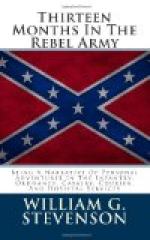As to small-arms, the energies of the South have been more fully developed in their manufacture than is dreamed of by the North. As early as April, 1861, Memphis had commenced the alteration of immense quantities of flintlock muskets, sent South during Floyd’s term as Secretary of War. I saw this work progressing, even before Secession was a completed fact there. New Orleans turned out the best rifles I ever saw in the South. They were similar to the French Minie rifle, furnished with fine sword-bayonets. The Louisiana troops were mostly armed with these. At Nashville and Gallatin, Tennessee, rifles were also made, and I suppose in every considerable city in the South. In addition, it should be known that thousands of Government arms were in the hands of the people, all through the Southern States; how they procured them I do not know. These were gathered up and altered or improved, and issued to the troops. Many of the regiments went into the field armed with every description of guns, from the small-bore squirrel-rifle and double-barreled shot-gun to the ponderous Queen Bess musket and clumsy but effective German Yager. The regiments were furnished as fast as possible with arms of one kind, and the others returned to the factories to be classified and issued again. Sword-bayonets were fitted to double-barreled shot-guns, making them a very effective weapon. Others were cut down to a uniform length of about twenty-four inches, and issued to the cavalry. Common hunting-rifles were bored out to carry a Minie ball, twenty to the pound, and sword-bayonets fitted to them. One entire brigade of Tennesseans, under General Wm. H. Carroll, was armed with these guns.
When recovering from sickness at Nashville, I spent hours of investigation in the base of the capitol, used as an armory, where an immense amount of this work had been done. I have been told that the basement of our National capitol has been used to prepare bread for loyal soldiers; that basement was used to prepare them bullets. At Bowling Green I saw many thousands of rifles and shot-guns which had been collected for alteration, and the machine shop of the Louisville and Nashville railroad was used as an armory. Many of these guns were destroyed, and others left, when the town was evacuated.




